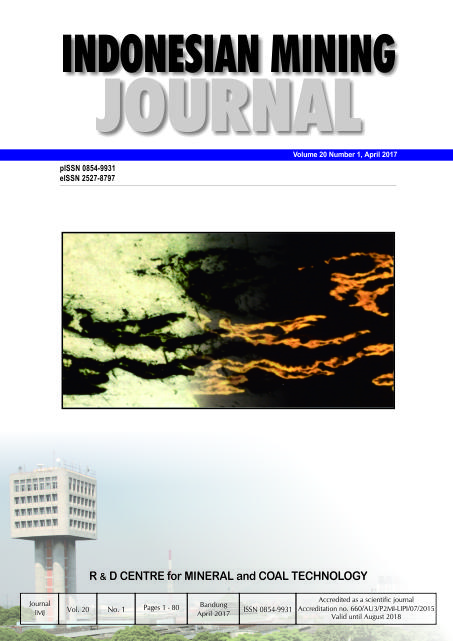DESORPTION OF GOLD AND SILVER FROM ACTIVATED CARBON
DOI:
https://doi.org/10.30556/imj.Vol20.No1.2017.184Keywords:
loaded carbon, electrolyte, electrowinning, cake, bullion, gold and silverAbstract
Experiments of gold and silver elution were conducted using several parameters, either fixed or varying parameters. Ethanol volume, temperature and percent solid belonged to varying parameters while loaded carbon, stirring rate, concentrations of NaOH and NaCN served as fixed parameters. The experiment results showed that the optimum condition for such a process included 20% of ethanol volume, 80°C of temperature and solid fraction of 25%. Using such condition, the experiment was conducted for 10-hour contact time and yielded the highest desorption percentages for gold and silver, namely 80.10 and 70.73% respectively. The derived contents of gold and silver were 295.16 and 159.38 ppm while their achieved weights were 56.080 and 30.601 µ g. The fact that the achieved contents of gold and silver was close to the requirements for electrowinning process, it is suggested that the next process using a semi-continue one in terms of gaining a result that satisfies the requirement for electrowinning.References
Andrade de Lima, L. R. P. (2007) “Dynamic simulation of the carbon-in-pulp and carbon-in-leach processes,” Brazilian Journal of Chemical Engineering, 24(4). doi: 10.1590/S0104-66322007000400014.
Bhattacharyya, D. (2013) Aurodicyanide desorption from activated carbon. University of Utah.
van Deventer, J. S. J. and van der Merwe, P. F. (1994) “Factors affecting the elution of gold cyanide from activated carbon,” Minerals Engineering, 7(1), pp. 71–86. doi: 10.1016/0892-6875(94)90148-1.
Elnathan, F. (2007) The effect of activated carbon particle size on gold cyanide adsorption and elution. University of Utah.
Espiell, F., Roca, A., Cruells, M. and Núñez, C. (1988) “Gold desorption from activated carbon with dilute NaOH/organic solvent mixtures,” Hydrometallurgy, 19(3), pp. 321–333. doi: 10.1016/0304-386X(88)90038-2.
Griffin, A. F. (1982) “Carbon Desorption Process Development at Micron Research (Western Australia),” in Seminar on Carbon-in-Pulp Technology for the Extraction of Gold. Perth, W.A.: The Australian I.M.M Perth and Kalgoorlie Branches and Murdoch University.
Heinen, H. J., Peterson, D. G. and Lindstrom, R. E. (1980) “Desorption of gold from activated carbon.” United State of America.
Kohl, P. A. (2010) “Electrodeposition of gold,” in Schlesinger, M. and Paunovic, M. (eds.) Modern Electroplating. 5th Editio. Hoboken, NJ, USA: John Wiley & Sons, Inc., p. 736. doi: 10.1002/9780470602638.
Lunga, A. L. (2006) Optimizing the operating conditions of gold elution and electrowinning for Tau Lekoa stream at Kopanang gold plant. University of the Witwatersrand.
Nakahiro, Y., Kawaguchi, T., Kusaka, E., Niinae, M. and Wakamatsu, T. (1992) “A Study on Recovery of Gold with Activated Carbon from Leaching Solution by Acidothioureation.,” Shigen-to-Sozai (Journal of the Mining and Materials Processing Institute of Japan), 108(1), pp. 46–50. doi: 10.2473/shigentosozai.108.46.
Oladele, T. P. (2015) Effect of temperature, contact time and agitation speed during pre-treatment on elution of gold. Stellenbosch University.
Parga, J. R., Valenzuela, J. L. and Díaz, J. A. (2012) “New Technology for Recovery of Gold and Silver by Pressure Cyanidation Leaching and Electrocoagulation,” in Su, Y.-H. (ed.) Noble Metals. InTech, pp. 71–94. doi: 10.5772/32673.
Radulescu, R., Filcenco-Olteanu, A., Panţuru, E. and Grigoraş, L. (2014) “New Hydrometallurgical Process for Gold Recovery,” Chem. Bull. “POLITEHNICA” Univ. (Timişoara), 53(67)(1–2), pp. 135–139.
Sayiner, B. (2014) “Modeling of the carbon-in-pulp (CIP) process in gold cyanide leaching plants using plant data,” Physicochemical Problems of Mineral Processing, 50(2), pp. 841–851. doi: 10.5277/ppmp140234.
Downloads
Published
Issue
Section
License
Indonesian Mining Journal provides immediate open access to its content on the principle that making research freely available to the public to supports a greater global exchange of knowledge.

This work is licensed under a Creative Commons Attribution-NonCommercial 4.0 International License.













